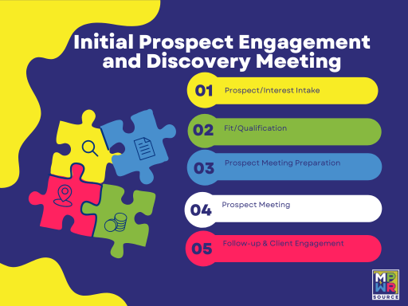How to Conduct a Sales Meeting
An important part of B2B Sales is conducting sales meetings with your sales team. Sales meetings...

There are five steps to a discovery meeting, which include prospect intake, qualification, prospect meeting preparation, prospect meeting, and follow-up. As you can see, a discovery meeting starts before you meet with the prospect. The actual meeting does not even occur until the fourth step. A discovery meeting is considered the first initial meeting with a prospect, which can occur virtually or face-to-face. During a discovery meeting, you should ask questions to understand the needs and pain points faced by the prospect. Once you fully understand the prospect's needs and pain points, you can discuss how you can effectively meet their needs and ease or eliminate their pain points. Also, you should give a lot of time to the prospect to ask questions.

What should you do before a discovery meeting?
Research
Before the discovery meeting, you will want to be as prepared as possible for the meeting. Create a questionnaire for you to complete before the discovery meeting. Make sure you know or have the following before the discovery meeting:
Plan
To run a successful discovery meeting, you need to have a plan. You need to read and study the research you collected above. You need to understand your client(s) as much as possible before conducting the discovery meeting.
Additionally, be prepared with your discovery questions. Discovery questions are designed to obtain the context you need to begin formulating a strategy to achieve a solution. You are looking for clarity and justification around the wants, needs, dreams, and pain points, so come prepared with questions around those areas.
Create a standard set of questions, but you, undoubtedly, will come across unique situations that will require unique questions. Be prepared to produce questions based on the gaps you find in the existing documentation.
Agenda
Do not think that agendas are only for corporate meetings. When there is no agenda, it translates that you do not care. Therefore, the prospect inevitably feels that the meeting may be a big waste of their time.
The agenda should be simple, and it should be shared with the clients before the meeting. The agenda can be shared via email, text, or phone call, depending on the prospect’s preference. When you share with the prospect the agenda ahead of time, it does three things:
Additionally, the agenda allows you to clearly think and articulate what you want to get out of the meeting, as well to outline the next steps. A sample agenda for the discovery meeting could include:
What should you do during the Discovery Meeting?
Introductions
Build rapport by introducing yourself. Tell them about your purpose or your why, and share some personal information about yourself. Make sure to give the prospect enough time to share a little bit about themselves with you.
Last Time We Communicated
Indicate the last time you communicated with the client. It could be from a seminar, webinar, email, text, phone call, etc. Mirror back the questions or concerns they shared with you when you last communicated, and answer their questions.
Purpose
Highlight the purpose of the meeting. Indicated that you would like to understand their needs, wants, dreams, and pain points better, as well as give a sense of the solutions you provide. The purpose of the meeting is for you and the prospect to decide if a business relationship is worth exploring.
Review Agenda and Follow Agenda
Review the agenda with the prospect, so they can have a good sense of the direction of the meeting. Make sure to follow the agenda during the meeting.
Discuss Your Solutions
This is your opportunity to discuss your solutions with the prospect. Make sure to highlight values and unique selling proposition. Ideally, you would like the prospect to clearly understand why you have the best solution for them.
Demo Your Solutions
It may sound cliche, but seeing it is believing it. This is your opportunity to show them how your solution works. For example, if you are website developer, this is an opportunity to show a website you designed, as well as how easy it is to update.
Answer Questions
Open the meeting for the prospect to ask any and all questions. However, remember to periodically check in with the prospect during the meeting to answer any questions they may have right on the spot.
Next Steps
If you do the necessary fact-finding, research, and qualifying before the first meeting you will shorten the sales cycle. If you do the necessary homework before the discovery meeting, depending on your industry, your discovery meetings may have a 50% to 60% conversation rate. Always ask the following at the end of the first meeting:

An important part of B2B Sales is conducting sales meetings with your sales team. Sales meetings...

Sales teams work best when they have all the data they need right at their fingertips. When they...